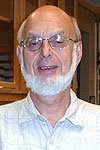
Walter Goldstein, PhD., MBA, P.E. will talk about his patented method of creating a universal blood supply using bioreactors. He has co-founded a company, TransCyte, Inc. to develop the technology,
Tuesday, December 11th at 11:30 AM Check-in/Networking 12 PM Lunch
McCormick & Schmicks: Lunch $30. 355 Howard Hughes Parkway, Las Vegas, NV
R.S.V.P. Judith Lynn Rebholz 839-7201 or jrebholz@cvbt.com
Tuesday, December 11th at 11:30 AM Check-in/Networking 12 PM Lunch
McCormick & Schmicks: Lunch $30. 355 Howard Hughes Parkway, Las Vegas, NV
R.S.V.P. Judith Lynn Rebholz 839-7201 or jrebholz@cvbt.com
Dr. Walter E. Goldstein is the former Coordinator of the UNLV Biotechnology Center. He is the co-founder of TransCyte, Inc. (a company formed to produce red cells from stem cells) as well as the President of Goldstein Consulting Company. He has led a research and development organization of 140 persons (35 Ph.D.'s) at Bayer (Miles, Inc.), a leading firm in biotechnology, clinical diagnostics, therapeutics, food ingredients, materials, chemicals, and consumer products. He led 35 persons (10 Ph.D.'s) at ESCAgenetics Corporation, which was a leading developer of plant-based technology for food, food ingredients and pharmaceuticals. He designed and developed cryogenic processes and equipment for Union Carbide Corporation. At the UNLV Biotechnology center he developed programs in forensic DNA profiling, microbiological identification, food safety, genetic basis for biotechnology improvements, and prevention of nosocomial infections.
Dr. Walter Goldstein holds a BS in chemical engineering from the Illinois Institute of Technology, an MS and PhD in chemical engineering from the University of Notre Dame, and an MBA from Michigan State University, with emphasis in finance, marketing, business law, and business organization. He is a Registered Professional Engineer. He has held faculty and research appointments in both the University (Notre Dame, UNLV) and private sectors.
Dr. Goldstein holds a number of patents including the process for producing a transfusable, oxygenating composition of human red blood cells by the ex vivo culturing, expansion and differentiation of human primitive hematopoietic cells. The process involves expansion of primitive hematopoietic cells in a first bioreactor containing one or more growth factors, differentiating the cells into erythroid progenitor cells in a second bioreactor containing one or more differentiation factors and effecting maturation of the erythroid progenitor cells into mature erythrocytes in a third bioreactor containing one or more maturation factors. The invention also provides a process for producing a transfusable, oxygenating composition of red blood cells by expansion and differentiation of primitive hematopoietic cells in a bioreactor containing a nutrient medium which includes perfluorocarbons which improve the exchange of oxygen and carbon dioxide between the cells and the nutrient media.
Dr. Walter Goldstein holds a BS in chemical engineering from the Illinois Institute of Technology, an MS and PhD in chemical engineering from the University of Notre Dame, and an MBA from Michigan State University, with emphasis in finance, marketing, business law, and business organization. He is a Registered Professional Engineer. He has held faculty and research appointments in both the University (Notre Dame, UNLV) and private sectors.
Dr. Goldstein holds a number of patents including the process for producing a transfusable, oxygenating composition of human red blood cells by the ex vivo culturing, expansion and differentiation of human primitive hematopoietic cells. The process involves expansion of primitive hematopoietic cells in a first bioreactor containing one or more growth factors, differentiating the cells into erythroid progenitor cells in a second bioreactor containing one or more differentiation factors and effecting maturation of the erythroid progenitor cells into mature erythrocytes in a third bioreactor containing one or more maturation factors. The invention also provides a process for producing a transfusable, oxygenating composition of red blood cells by expansion and differentiation of primitive hematopoietic cells in a bioreactor containing a nutrient medium which includes perfluorocarbons which improve the exchange of oxygen and carbon dioxide between the cells and the nutrient media.

















